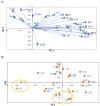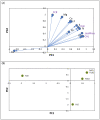Nutritional Performance of Five Citrus Rootstocks under Different Fe Levels
- PMID: 37765416
- PMCID: PMC10535202
- DOI: 10.3390/plants12183252
Nutritional Performance of Five Citrus Rootstocks under Different Fe Levels
Abstract
Iron is an essential micronutrient for citrus, playing an important role in photosynthesis and yield. The aim of this paper was to evaluate the tolerance to Fe deficiency of five citrus rootstocks: sour orange (S), Carrizo citrange (C), Citrus macrophylla (M), Troyer citrange (T), and Volkamer lemon (V). Plants were grown for 5 weeks in nutrient solution that contained the following Fe concentrations (in µM): 0, 5, 10, 15, and 20. At the end of the experiment, biomass (dry weight-DW), leaf area, total leaf chlorophyll (CHL), and the activity of root chelate reductase (FCR) were recorded. Additionally, the mineral composition of roots (R) and shoots (S) was evaluated. Principal component analysis was used to study the relationships between all parameters and, subsequently, the relations between rootstocks. In the first component, N-S, P-S, Ca-S, Cu-S, Zn-S, Mn-S, Zn-R, and Mn-R concentrations were related to leaf CHL and FCR. Increases in leaf CHL, Mg-R, and DW (shoots and roots) were inversely related to Cu-R, which was shown in the second component. The values obtained were consistent for V10, C15, and C20, but in contrast for S0 and S5. In conclusion, micronutrient homeostasis in roots and shoots of all rootstocks were affected by Fe stress conditions. The Fe/Cu ratio was significantly related to CHL, which may be used to assist rootstock performance.
Keywords: Fe chlorosis; citrus; ferric chelate reductase; mineral composition.
Conflict of interest statement
The authors declare no conflict of interest.
Figures



Similar articles
-
Spatial Distribution Characteristics of Micronutrients and Their Deficiency Effect on the Root Morphology and Architecture in Citrus Rootstock.Plants (Basel). 2025 Jan 8;14(2):158. doi: 10.3390/plants14020158. Plants (Basel). 2025. PMID: 39861512 Free PMC article.
-
First Report of Armillaria Root Rot Caused by Armillaria mellea Infecting Carrizo Citrange and Sour Orange Rootstocks in Turkey.Plant Dis. 2014 Oct;98(10):1439. doi: 10.1094/PDIS-05-14-0463-PDN. Plant Dis. 2014. PMID: 30703947
-
Effects of 4-month Fe deficiency exposure on Fe reduction mechanism, photosynthetic gas exchange, chlorophyll fluorescence and antioxidant defense in two peach rootstocks differing in Fe deficiency tolerance.J Plant Physiol. 2006 Feb;163(2):176-85. doi: 10.1016/j.jplph.2004.11.016. Epub 2005 Jun 8. J Plant Physiol. 2006. PMID: 16399008
-
Salinity level influenced morpho-physiology and nutrient uptake of young citrus rootstocks.Heliyon. 2023 Jan 31;9(2):e13336. doi: 10.1016/j.heliyon.2023.e13336. eCollection 2023 Feb. Heliyon. 2023. PMID: 36755611 Free PMC article.
-
SuperSour: A New Strategy for Breeding Superior Citrus Rootstocks.Front Plant Sci. 2021 Nov 4;12:741009. doi: 10.3389/fpls.2021.741009. eCollection 2021. Front Plant Sci. 2021. PMID: 34804088 Free PMC article. Review.
Cited by
-
Transcriptome Profiling Reveals the Effects of Rootstocks on Scion Architecture in Malus domestica Borkh Var. 'Harlikar'.Plants (Basel). 2025 Feb 24;14(5):696. doi: 10.3390/plants14050696. Plants (Basel). 2025. PMID: 40094595 Free PMC article.
References
-
- Saito A., Shinjo S., Ito D., Doi Y., Sato A., Wakabayashi Y., Honda J., Arai Y., Maeda T., Ohyama T., et al. Enhancement of Photosynthetic Iron-Use Efficiency Is an Important Trait of Hordeum vulgare for Adaptation of Photosystems to Iron Deficiency. Plants. 2021;10:234. doi: 10.3390/plants10020234. - DOI - PMC - PubMed
-
- Rombolà A.D., Tagliavini M. Iron Nutrition of Fruit Tree Crops. Iron Nutrition in Plants and Rhizospheric Microorganisms. Springer; Dordrecht, The Netherlands: 2006. pp. 61–83.
-
- Álvarez-Fernández A., Melgar J.C., Abadía J., Abadía A. Effects of Moderate and Severe Iron Deficiency Chlorosis on Fruit Yield, Appearance and Composition in Pear (Pyrus communis L.) and Peach (Prunus persica (L.) Batsch) Environ. Exp. Bot. 2011;71:280–286. doi: 10.1016/j.envexpbot.2010.12.012. - DOI
-
- Pestana M., De Varennes A., Goss M.J., Abadía J., Faria E.A. Floral Analysis as a Tool to Diagnose Iron Chlorosis in Orange Trees. Plant Soil. 2004;259:287–295. doi: 10.1023/B:PLSO.0000020979.83817.b4. - DOI
Grants and funding
LinkOut - more resources
Full Text Sources
Miscellaneous

